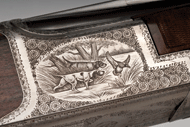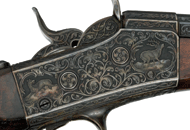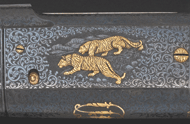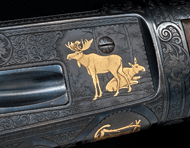|
Cowan's Corner
Engraving on 19th-Century Firearms:
Rare and Beautiful Works Bring High Prices
By Wes Cowan
On the rare occasion that a firearm
featuring engravings from one of
several 19th-Century masters comes
to auction, the interest is high and
the bidding fierce. Firearms with
engravings by top-tier engravers like
Gustave Young, Louis Nimschke or
John or Conrad Ulrich can easily realize
a six-figure price at auction today.
Collectors value firearms with
engravings in styles such as Bulino,
which reproduces birds and other
animals using tiny cuts that are enhanced
by light and shadow to create
a scene. The craftsmanship
of these vintage firearms
is incredible, especially
considering that 100
years ago, the cost
of engraving was a
fraction of the total
cost of the gun. This
is hard to comprehend,
since an engraver
needed 20-30 years of
experience to be considered
a master at his craft.
The late 19th Century, considered the
golden age of gun engraving, produced
four master engravers who were all
of German heritage. These engravers
have a loyal following by today’s
affluent firearms collectors. Gustave
Young was Colt’s primary engraver in
the 1850s-1870s. He later engraved
for Smith & Wesson, from the 1870s to
1890s.
Louis D. Nimschke, based in New
York, flourished from 1850-1900. He
worked independently and engraved for
Colt, Winchester, Remington, Spencer
and more than 100 other different gun
makers. It is estimated that he engraved
5,000 guns in his lifetime, and he
developed an international following.
He signed his engraving on long arms
about 85% of the time, but he rarely
signed revolvers.
John Ulrich and Conrad Friedrich
Ulrich were brothers who engraved primarily for Winchester in the last
quarter of the 19th Century. They also
occasionally worked for Marlin Co.
‘Though extremely beautiful,
engravings on 19th-Century firearms
were not purely for decoration; they
helped to retain oil on the metal to
prevent rust, and they also helped to
reduce the glare off the metal’s shiny
surface. The color-hardening process
performed on the metal, often admired
for its resulting aesthetics, also
protected the gun from rust and wear.
The engraving, wood, and other
metal surfaces of these guns
were crafted to be handled,
and in today’s auction
market, the expected wear
adds to the character of a
gun.
Today, many
engravers try to imitate
the masters of the golden
age, but experts can tell the
difference. Even though some
of the same tools and patterns
are used, the individuality of the
engraver’s work is missing, allowing
an expert to detect a contemporary
copy.
Paying six figures for a firearm
may not be an option for everyone, but
works with lovely detailed engravings
can be bought at auction for under
$20,000 by a discerning collector.
No matter what your price range, the
beauty and splendor of these guns can
surely be appreciated as a piece of
history and as works of art.
 About the author: Wes Cowan is founder and owner
of Cowan’s Auctions, Inc. in Cincinnati,
Ohio. An internationally-recognized
expert in historic Americana, Wes
stars in the PBS television series
History Detectives and is a featured
appraiser on Antiques Roadshow.
He can be reachedvia email at
info@cowans.com. Research by Joe
Moran. About the author: Wes Cowan is founder and owner
of Cowan’s Auctions, Inc. in Cincinnati,
Ohio. An internationally-recognized
expert in historic Americana, Wes
stars in the PBS television series
History Detectives and is a featured
appraiser on Antiques Roadshow.
He can be reachedvia email at
info@cowans.com. Research by Joe
Moran.
|

FN Model B-25 Broadway Trap Over
and Under shotgun with Bulinostyle
engraving, estimated to sell for
$12,000/$15,000.

Remington No. 1 Long Range
Exhibition Grade rifle, sold for
$85,250.

Savage Model 1899 rifle made for
John F. Dodge, estimated to sell for
$200,000/$250,000.

Winchester Model 1886 rifle made
especially for John F. Dodge with
John and Conrad Ulrich engravings,
estimated to sell for $400/$500,000.
|